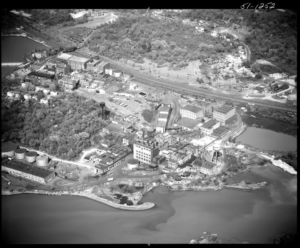
Peekskillian Malaka Garrett, who works at City Hall, sometimes wonders why the Town of Cortlandt virtually envelops the small City and ponders how the relationship between the two municipalities evolved.
Peekskill’s separate identity from Cortlandt dates to the mid-1600s.
The area around Annsville Creek (kill in Dutch) became well known in New Amsterdam after Jan Peek, the town’s namesake, arrived around 1654 and established a trading post. Peek’s prosperity attracted other settlers upriver – arguably the first suburbanites to move north.
In 1664, the new English governor in New York began apportioning land by approving treaties between private parties and local natives. Stephanus Van Cortlandt eventually patched together a 86,000-acre parcel stretching from the Croton River to just north of Anthony’s Nose, then east all the way to the Connecticut line.
But in 1685, the authorities also let a group of six Dutch settlers carve out 1,800-acres along McGregory Brook and beyond. Known as the Ryck’s Patent, it served as the nucleus of Peekskill’s future.
During the Revolutionary War, “Peekskill was the first Continental Army regional base camp, from November 1776 to April 1778,” said former City Historian John J. Curran. The Brits raided the encampment in March 1777 and returned again in October.

General George Washington held strategy meetings further inland at Van Cortlandt Manor in Van Cortlandtville and began bouncing around the Hudson River valley to stay a step ahead of the foe. Later on, he returned to Birdsall House (not the current pub), sometimes sticking around for months at a time.
In the 1800s, Peekskill experienced growing pains. Industry crowded the waterfront and a free-for-all atmosphere informed the quality of life.
The City seal features a plow and a cast-iron stove for a reason. The remnants of iron mines still pockmark the surrounding hills, but in the 1890s, prospectors discovered a rich vein of cheap ore in Minnesota that eventually put local forges, foundries and factories out of business here.
Along with heavy industries, large-scale garment businesses also began to fold, although the 65-acre Fleischmann’s complex, established at Charles Point in 1899, continued to hum through 1977.
An early sign of Peekskill’s dissatisfaction with the Town of Cortlandt’s governance emerged in 1816, when locals created a fire district and first levied taxes 11 years later.
The taste of autonomy, along with perennial gripes about paying for roads and other infrastructure in far-flung nooks of the town – like bridges over the Croton River – spurred local leaders to incorporate as a village in 1839 and exert more authority.
One historian recounted the scene: “Pigs, cattle and chickens roamed at will, and ashes and garbage were dumped in the streets.”

That changed when village trustees passed ordinances regulating cattle, public auctions, street obstructions and proper Sunday behavior. They also enacted a dog tax and shuttered a soap and candle factory, calling it a public nuisance.
In the late 1800s, as Peekskill attracted tourists from the city and factory workers played hard, the place acquired an unsavory reputation as a wild River Town filled with saloons and vice.
An influx of immigrants from southeast Europe helped spawn a local Ku Klux Klan chapter. In 1928, Klansmen triggered a riot when they attempted to burn a cross in largely Irish and Italian Verplanck after Herbert Hoover defeated Al Smith, the first Catholic presidential nominee. Camp Smith, one portion of the 1685 Ryck’s Patent, is named for him.
In 1949, the Klan and anti-Communist veterans injured more than 150 people during two appearances by singer, athlete, actor and activist Paul Robeson (see separate article in this issue). Even though the violence unfolded in Cortlandt, the events are known as the Peekskill Riots.
During the Depression, Town of Cortlandt officials voted themselves raises in 1934, which angered Peekskillers (there is no universally accepted term for locals).
Two years later, the county Board of Supervisors floated a proposal to partition Westchester into 10 administrative districts with almost all power concentrated in White Plains. To protect the village from the proposed predation and also shed Cortlandt’s administrative yoke, Peekskillites voted to establish a city charter.
Despite delays caused by pitched legal battles with the county, Cortlandt and Albany, city status arrived in 1940. Prominent local citizen Charles A. Smith aided the cause with a timely phone call to the home of Governor Herbert H. Lehman.
The planned county power grab also spurred Rye (population 16,383) to follow suit in 1942. Today, both cities are two of the nation’s smallest. With a population of 25,740, Peekskill doesn’t crack the top 1,000.
The City may be tiny, but its rich history is well documented. In general, the Peekskill Museum preserves the artifacts, including several cast-iron stoves, and the Field Library’s Local History Collection houses the papers.
“We have a lot of families that go back to the Revolution and beyond who never left,” said Sarah Scott, Local History Librarian at the Field Library. “They’re passionate about trying to keep the past alive.”
Marc Ferris, a River Journal regular contributor, is the author of Star-Spangled Banner: The Unlikely Story of America’s National Anthem.






